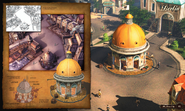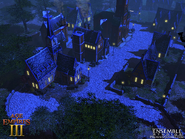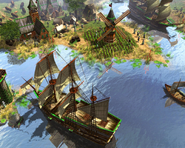| This article is about the civilization in Age of Empires III. For the civilization in Age of Empires II, see Teutons. |
The Germans are a playable European civilization in Age of Empires III. The Kingdom of Prussia was one of the nation states in Germany and was a European kingdom from the early 17th century until the early 20th century. The Prussians fought several wars against France during the 18th and 19th centuries, usually with Great Britain as its ally. In the 1870s, the several nation states in German lands (including Prussia) finally united, resulting in the formation of the German Empire.
In the New World, the Germans ruled territories in South America in the 16th century such as Venezuela. They were short-lived, however, and the Germans would not colonize successfully until the late 19th century.
Overview
Berlin, the German Home City
The Germans start off with fewer, but faster gathering villagers than other civilizations. They receive free Uhlans with almost every Home City Shipment, though they require more experience points per shipment (the opposite of the Spanish). Their early age economy is good, since their Settler Wagons essentially work at the rate of two villagers. The two Settler Wagon shipments in the Discovery Age and the three Settler Wagon shipment in the Colonial Age are very useful. Although Settler Wagons are only available through the Home City in the beginning, they can later be trained at the Mill with the "Germantown Farmers" card. This card requires a level 25 Home City.
Because the Germans almost always have Uhlans, they have a lot of cavalry, but their late-developing army is diverse. They have a powerful anti-infantry force since German Skirmishers can be upgraded to Needle Gunners and the Doppelsoldner is a formidable close-combat infantry unit.
German cavalry is one of the strongest in the game in terms of attack. The War Wagon has a large amount of hit points, while the Uhlans have low HP but a devastating attack. The War Wagon is slower than other Dragoon-type units (speed of 6 vs 7.25) but has additional range (16 vs 12 unupgraded) and has 20% melee resistance instead of the usual 30% ranged resistance. Also, War Wagons have a mini setup-animation-delay before shooting, where other Units shoot almost instantly. Therefore, players cannot hit and run with WW.
Their cavalry can further be strengthened with over five shipments that can aid their combat ability, though two of them are not efficient. The Germans can also obtain free mercenary shipments at a lower Home City level than any other civilization.
They appear in the Act I: Fire (The War Chiefs) as the Hessians, and are allied with the British. The reason for this is because the British used several Hessian mercenaries in the War of Independence.
The German AI in skirmish is the only AI to utilize imperial cannons because AIs do not use factories to produce artillery.
Features
- Receive Uhlans with Home City shipments (except TEAM ones) from Colonial Age and beyond (mercenary shipments contain more units instead) but Home City shipments require +10% XP to be earned
- Starts with three Settler Wagons
- Royal Guard units: Skirmisher (Prussian Needle Gunner), Uhlan (Czapka Uhlan)
Unique units
 Settler Wagon: A German villager that is more expensive but gathers faster than a Settler.
Settler Wagon: A German villager that is more expensive but gathers faster than a Settler. Doppelsoldner: Heavy swordsman with a sweep attack.
Doppelsoldner: Heavy swordsman with a sweep attack. Uhlan: Light cavalry that sacrifices hitpoints for attack.
Uhlan: Light cavalry that sacrifices hitpoints for attack. War Wagon: Hussite horse-drawn wagon outfitted with cannon.
War Wagon: Hussite horse-drawn wagon outfitted with cannon.
Home City Cards
- Main article: German Home City Cards
Revolutions
- José de San Martín and Simón Bolívar (In The Warchiefs and The Asian Dynasties)
- Gran Colombia, Argentina, Hungary and Romania (Since the Definitive Edition)
In-game dialogue
German units (including mercenaries) speak modern Standard German with a standard theater pronunciation ("Bühnendeutsch"), although this does not represent the form of German spoken in the Age of Empires III timeframe.
General
- Ja? (Yes?)
- Hallo! (Hello?)
- Bereit! (Ready!)
- Aufgabe? (Orders?)
- Auftrag? (Order?)
- Ja (Yes)
- Jawohl! (Yes!)
- Verstanden (Understood)
- Richtig (Right)
- Wird gemacht! (Will be done!)
- Wird erledigt! (It will be done!)
- Holzfäller (Lumberjack)
- Händler/Händlerin (Miner, literally "Merchant")
- Zimmermann (Carpenter / House builder)
- Jäger/Jägerin (Hunter)
- Sammler/Sammlerin (Gatherer)
- Bauer/Bäuerin (Farmer)
- Angriff! (Attack!)
- In den Kampf! (Into the fight!)
Explorer
- Ich bin verwundet und kann mich nicht bewegen. (I've been wounded and can't move.)
- Danke, dass du mein Lösegeld gezahlt hast. (Thanks for paying my ransom.)
- Es geht mir besser. (I'm feeling better.)
- In Namen von Deutschland fordere ich dieses Land. (In the name of Germany, I claim this land.)
Trivia
- The German flag shown in the original game appears to be a combination of the state flag of the Kingdom of Prussia (1750–1801) and Imperial Banner of the Holy Roman Emperor (ca. 1430–1806). It was changed to the Imperial Standard of the Holy Roman Empire (16th–19th century) in the Definitive Edition[1].
- According to early screenshots prior to the release of Age of Empires III, the German flag in the game would be the Colonial flag used by the German Empire between 1884–1918.
History
| “ | At the time of Columbus' first voyage, Germany consisted of four hundred separate entities, including cities, principalities, and feudal states. Though nominally part of the Holy Roman Empire, they were in fact beyond the control of the Holy Roman Emperor in Spain. There was no central government that dictated policy, collected taxes, or marshaled armies. In 1517 a German monk, Martin Luther, protested against a variety of practices of the Catholic Church by nailing his arguments to a church door in Wittenberg. This was a traditional way of opening a debate at the university there, but he started something larger than a scholarly debate. His act set off the Protestant Reformation, as copies of his theses, translated from Latin into German and other languages, spread throughout Germany and the rest of Europe. The Reformation in turn brought about the Counter-Reformation as the Catholic Church reordered itself. The struggle between the two religious views broke out into the Thirty Years' War, which was particularly brutal and devastating in Germany. German provinces ended up choosing to be either Catholic (primarily in the south) or Protestant (primarily in the north). The small Baltic duchy of Prussia gradually began expanding in the sixteenth century thanks to good leadership and a growing military tradition. It repulsed Swedish encroachments in the seventeenth century and rose to real prominence under Frederick the Great in the eighteenth century. The Prussians were particularly noted for their disciplined infantry, elite Grenadiers, and cavalry. They fought a series of wars with the much larger Austrian Empire to the south, usually with great success, up to the Napoleonic Era. Germans briefly attempted to colonize Venezuela in the sixteenth century. Augsburg banking families obtained the rights to the country in 1526 and began exploring the land in 1529, mainly looking for El Dorado, the famed city of gold. Approximately two hundred settlers landed at Coro. They continued to search for gold and established some sugar plantations worked by African slaves. The colony reverted to Spanish control in 1556. Most of the German colonists had died from disease or native attacks, especially during their treks into the interior searching for gold. | ” |
Gallery
References
Template:Civilizations (AoE3)




